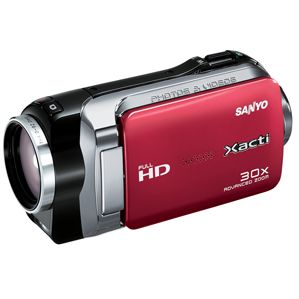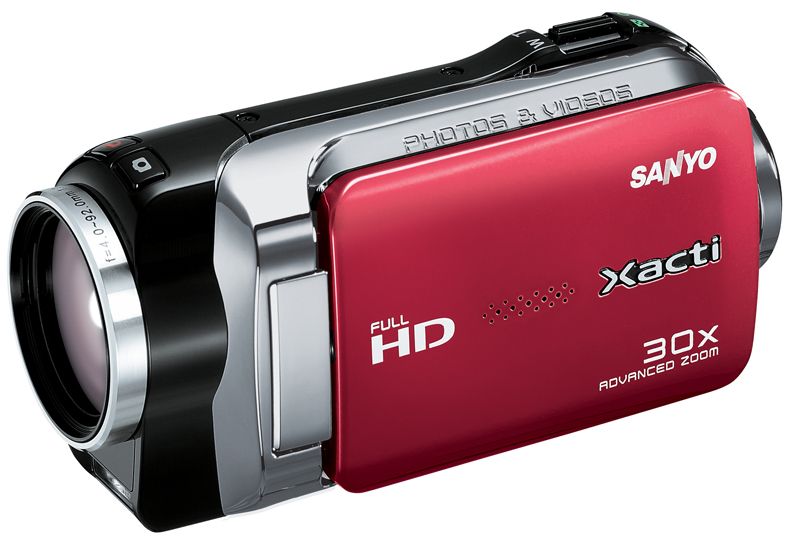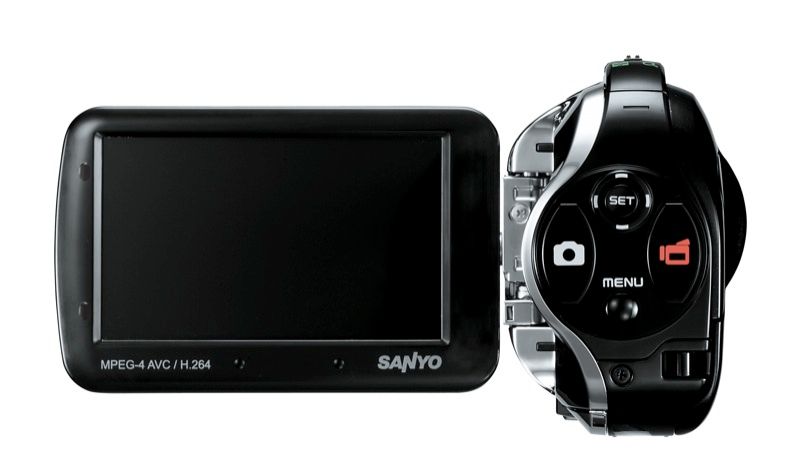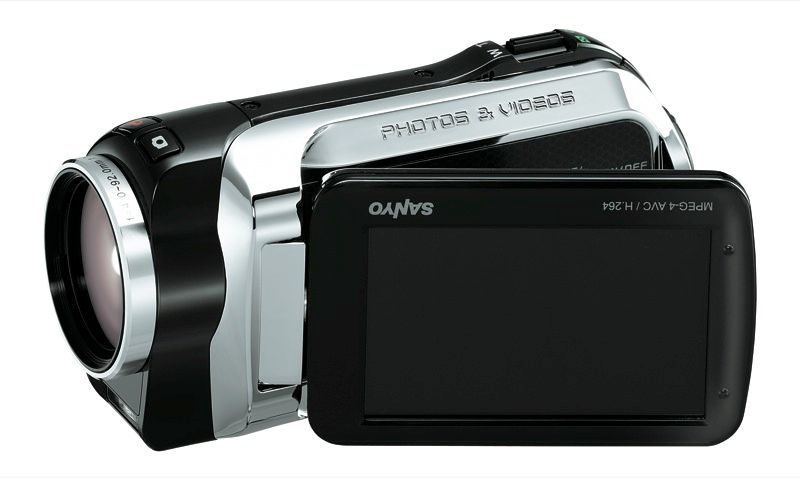Claimed to be the smallest and lightest in its class, the VPC-SH1 is Sanyo's latest range topping "dual camera". That's to say, although looking like a pocket camcorder pure and simple, now it has eschewed the Xacti range's eye-catching pistol grip design for more conventional horizontal layout, it offers 10-megapixel still photos plus Full HD widescreen ratio 1920 x 1080 video at a frame rate up to 60fps, courtesy of a 4-megapixel CMOS sensor.
Our quick take
Compact dimensions and instantly reachable controls means that operating the Sanyo Xacti VPC-SH1 is a fluid and intuitive process. And so, whilst this may be less flashy and its image quality less impressive than devices with better lenses and additional hard drives costing twice the price, the SH1 will invariably get taken out more often.

Sanyo Xacti VPC-SH1 camcorder - 3.5 / 5
| FOR | AGAINST |
|---|---|
|
|
On paper at least this "best of both worlds" spec matches or betters that offered by physically larger HD devices from brands including Canon, JVC, Sony, and Panasonic costing around £300 more. So, is the VPC-SH1, whilst not cheap for Sanyo itself at a suggested £349, nevertheless the good value it seems in comparison with the big boys?
There's undoubtedly been some subtle cost cutting to bring the device in at this price. For starters, squeeze the VPC-SH1's chassis and you'll discover a slightly plasticy feel. Only slightly mind, meaning it's well disguised by the attractively glossy exterior with sleek rounded edges, further distraction provided by the neatly ergonomic indentation to the right hand side that allows it to sit snugly within the palm, and enjoy a narrower overall depth than competing devices.
The SH1 will just about squeeze into the pocket of your jeans, but a jacket pocket feels its right destination. It weighs a reasonable 235g with battery (charged within the camera with mains lead and adapter plug provided) plus media card inserted. Dimensions are a manageable 42.8 x 117.9 x 59.2mm, a flash is tucked under the lens at the front, adjacent to the mains port. Battery life is good for 2 hours of recording, or around 350 still photos.
There's no automatic lens cover to protect the glass at the front from dirt and scratches, as offered by more expensive models, merely a clip-on cap that will quickly get lost or discarded.
Recording is to SD/SDHC or newer high capacity SDXC card - both optional but essential additional purchases - slotted into an opening hidden by the fold-out 2.7-inch, 230k dot resolution LCD screen in the absence of an electronic viewfinder. There's no large capacity hard drive as a storage alternative, but Sanyo provides 50MB to get users started out of the box.
Compatibility is further provided with new Eye-Fi media cards; inserting one effectively makes the VPC-SH1 a wireless device. If you haven't inserted a card, upon power up a voice prompt warns you that any footage will be committed to internal memory; helpful for beginners perhaps, but the sampled dialogue can quickly become irritating.
As you'd intuitively expect, flipping the LCD outwards at 90 degrees to the body automatically powers up the device, allowing the user to be up and recording in just over 2 seconds. Filming is really just as simple as pressing the record button to start and once again to end. Though there is an actual power button, mystifyingly it's hidden out of sight beneath the monitor - stored screen inwards - when the SH1 is inactive. The LCD can be tilted forward or back to a limited degree to provide a variety of compositional and viewing angles.
In practice, one thing we missed about the earlier pistol grip style Xacti models was the ability to use the fully extended LCD as a natural means of steadying the device - screen gripped pincer-like in the thumb and forefinger of your left hand - whilst your right hand curled around the grip itself. To our minds, the SH1 didn't feel quite as steady or as comfortable to hold.
Whilst its design may be less challenging than predecessors, little touches impress, like dual pairs of recording buttons - one falling under thumb at the rear, the other under forefinger due to their location just behind the lens.
There's also quite a comprehensive array of recording options, accessed with a press of the "menu" button wedged between a separate shutter release button (for stills) and red video record button at the back, with joystick labelled "set" for their implementation sitting directly above.
In video record mode the options are the Full HD 1920 x 1080 pixels in either 60 fields a second or 30 frames per second, a slightly lower "HD ready" 1280 x 720 pixels at 60fps or 30fps, further 960 x 540 at 30fps option, or standard definition 640 x 480 pixels at 30fps. There are further web friendly modes of 448 x 480 or 192 x 108 pixels at a whopping 300fps or 600fps respectively.
The video format is Motion JPEG, more accessible for those with ageing computers than AVCHD utilised by higher priced models, which requires an Intel based Mac for starters. Take a look at our clips to see what the quality is like at various settings (HD here, SD here, both on YouTube).
With a 35mm equivalent lens, the 30x "Advanced" zoom - a smooth in action combination of optical and digital zoom - is operated by a toggle switch on the SH1's top plate, where it falls under the forefinger as your thumb selects the respective photo or video recording modes at the back. It's commendably quiet in operation.
The SH1's built-in microphone does however pick up wind noise - even a light breeze by the river on an otherwise seemingly perfect day - but then that's not unusual for devices at the cheaper (sub £600) end of the consumer camcorder market. Also, when shooting fairly quiet interiors and replaying footage on your flat panel TV, there's some microphone and background "buzz" audible meaning that sound quality is merely adequate for a pocket model. Recording in low or natural light invariably means a loss of sharp detail.
Output is via mini HDMI port, with that cable unsurprisingly costing extra. You do also get combined AV/USB port, with relevant lead provided.
Still image quality - at top 10-megapixel setting - is fairly disappointing. The results, in effect 4-megapixel originals interpolated up in size, more closely resemble fuzzy video grabs than clearly defined photographs. Sanyo has been ploughing the dual camera/Xacti format for nearly a decade now - surely it can, and should, be delivering more convincing looking stills?
To recap
Delivering Full HD video with the minimum of fuss and at a reasonable price, the Sanyo VPC-SH1 is one of the simpler flash memory devices out there



